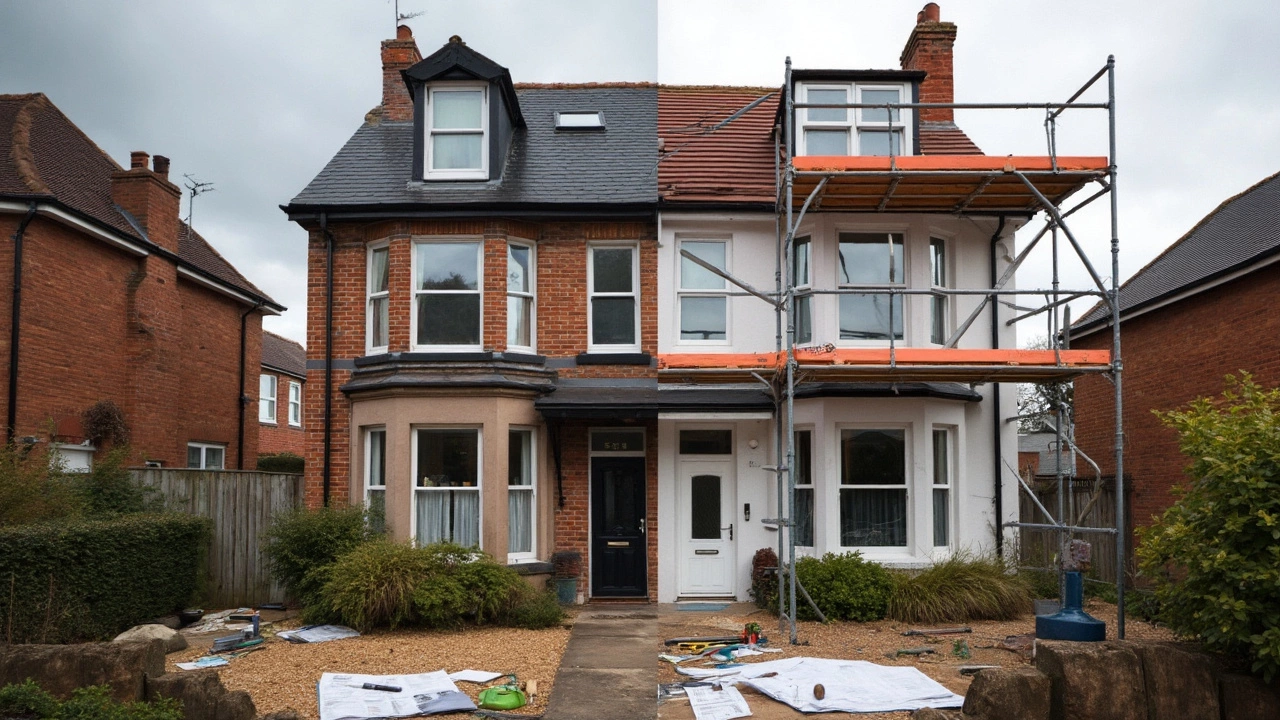Ever stand in the middle of your kitchen and wonder if you’re supposed to remodel or renovate? You’re not alone. Most people mix up these two words, but the truth is, they can cost you big if you choose the wrong route for your home project. Getting clear on the difference upfront not only saves you money, it can help you avoid weeks of frustration—and yep, maybe even a run-in with the local building inspector.
If you’re itching to change the look or feel of your home, you’ve come to the right place. I’ll break down what really separates remodeling from renovating, without any jargon. We’ll look at the definitions, how each one affects your wallet, what kind of sign-offs you’ll need, and how each choice could nudge your home’s value up (or down).
You’ll get hands-on tips, some of them from folks who took on these projects themselves—think kitchen redos where the stove landed in the laundry room, and real stories of bathroom makeovers gone right (or sideways). Let's clear up the confusion so your next home project actually delivers what you want—and doesn’t become an endless money pit.
- Remodeling vs Renovating: What Do They Really Mean?
- Budgeting Smarts: Which Costs More?
- Legal Stuff and Permits: What You Need to Know
- How Each Affects Your Home’s Value
- Tips for Picking the Right Approach
Remodeling vs Renovating: What Do They Really Mean?
Here’s where it gets real. Folks toss around the words “remodel” and “renovate” like they’re the same thing, but they’re not. Think of remodeling as making major changes to your home’s structure or layout. You’re not just refreshing; you’re actually changing the way a space looks or works—like taking down a wall to open up your kitchen or turning a small bathroom into a giant walk-in shower.
Renovating is more about bringing what you already have back to life. You work with the bones of your home, giving the place a solid facelift. Paint, new cabinets, refinished floors, or swapping out old windows—these are classic renovation moves. No massive floor plan changes or moving pipes from one side of the room to the other.
- Remodeling: Changing the structure or form of a room. Example: Converting a garage into a living room, or combining two bedrooms into one.
- Renovating: Refreshing or repairing elements without changing the main structure. Example: Replacing kitchen cabinets or fixing up your old, cracked tiles.
Here’s a quick stats rundown to put it into perspective:
| Project Type | What Changes? | Typical Cost Range (USD) |
|---|---|---|
| Remodeling | Layout, structure, systems | $15,000 – $75,000+ |
| Renovating | Surface updates, repairs | $2,000 – $20,000 |
Remodeling usually means a bigger investment, more planning, and sometimes a headache with permits and codes. Renovation, on the other hand, is more about good old-fashioned upkeep and sprucing up without turning your house into a construction site for months.
If you just want a space to look fresh and run better, renovation’s your move. If you want new walls, new rooms, or a home that works in a totally different way, you’re in the remodeling zone. The difference seems small, but it decides everything from your budget to whether you’ll need an architect—or a sledgehammer.
Budgeting Smarts: Which Costs More?
Here’s the deal: when you start looking at your wallet, remodeling almost always ends up being more expensive than renovating. Why? Remodeling means you’re changing the actual layout—think tearing out walls, moving pipes, or switching where the kitchen is. Renovating is more about bringing things back to life. A coat of paint, swapping out cabinets, or refinishing floors usually don’t break the bank because you’re working with what’s already there.
If you’re staring down a big project, check out this quick breakdown showing the average ballpark costs per square foot for 2025:
| Project Type | Average Cost/Sq Ft |
|---|---|
| Renovation | $20 - $60 |
| Remodeling | $45 - $125 |
Pretty wild gap, right? Those numbers add up fast, especially if you’re planning to fix up a bigger space like a basement or kitchen. Remodeling costs shoot up because you’re often paying for things like engineering, permits, electrical rewiring, new plumbing, and—don’t forget—unexpected surprises behind the walls. If you stick with renovating, the cash usually goes toward surface-level stuff: materials, paint, maybe some updated fixtures.
Want to keep it affordable? Here are some money-smart tips before you grab that sledgehammer:
- Start with a solid budget and add at least 15% extra for the surprises (there are always surprises).
- Get multiple quotes from contractors—prices can swing a lot between companies.
- Decide if any work is DIY-friendly (painting a room, swapping hardware) but leave the tricky electrical or plumbing stuff to a pro.
- Keep structural changes to a minimum if you want to save the most—moving walls means bigger bills.
Bottom line: renovation usually costs less, but if your home needs a major change, sometimes there’s no way around remodeling. Planning ahead and knowing what you’re getting into will help you dodge budget disasters.

Legal Stuff and Permits: What You Need to Know
Skip the permit, and you could hit a wall—literally and legally. Believe it or not, the difference between remodeling and renovating can decide if you need to deal with city paperwork or not. Here’s the straight story.
If you’re just swapping out old fixtures, painting, or even putting in new cabinets, you’re usually in the clear. Most basic renovations don’t need a permit. But once you start changing the structure—think moving walls, adding windows, or messing with plumbing and electrical—local law usually wants a say. In other words, almost every remodel project will need a permit.
- Renovation permits: Needed if you touch anything that involves wiring, plumbing, or the home’s structure (like knocking through a wall for an open kitchen).
- Remodel permits: Practically guaranteed—moving a wall, converting a garage, or adding rooms? Expect paperwork and inspections.
- HOA rules: If you belong to a homeowner’s association, always double-check their policies too. Some projects need HOA approval even if the city says it’s fine.
Here’s a quick look at what usually needs a permit and what doesn’t:
| Project | Permit Needed? |
|---|---|
| Replacing kitchen cabinets | No |
| Adding a bathroom | Yes |
| Taking down a non-load bearing wall | Yes, in most cities |
| Painting or tiling | No |
| Upgrading electrical panel | Yes |
Permits aren’t just red tape. Without one, insurance claims can get denied and you could be forced to undo the work if your city finds out. In 2023, the National Association of Realtors found that about 29% of home projects without proper permits led to legal headaches or extra fines.
So, before picking up a sledgehammer, head to your local building department’s website or office. Some places even let you apply online or get answers in a day. It’s usually way cheaper to get the permit now than pay double later if you skip it.
How Each Affects Your Home’s Value
If you’re thinking about putting your house on the market or just want to boost your investment, it matters whether you go for remodeling or renovating. These two aren’t equal when it comes to how much cash you’ll get back.
Renovating usually means fixing what’s already there—think painting the walls, swapping out floors, or replacing old fixtures. These updates are often cheaper and more about making the place look fresh, which buyers like. Remodeling, though, means changing the structure—a new kitchen layout, adding a bathroom, or taking down walls. This takes more money and time, but can seriously change how useful your house is.
Check out how much you’ll typically get back from popular projects (based on national data from the 2024 Cost vs. Value Report):
| Project | Type | Average Cost | Return on Investment (%) |
|---|---|---|---|
| Minor Kitchen Remodel | Renovation | $27,000 | 86% |
| Midrange Bathroom Remodel | Renovation | $25,000 | 67% |
| Major Kitchen Remodel | Remodeling | $79,000 | 54% |
| Adding a Master Suite | Remodeling | $155,000 | 45% |
| Replacing Front Door | Renovation | $2,500 | 91% |
See the pattern? Simple upgrades often bring in better returns than huge structural changes. New paint, shiny handles, or fresh floors are usually money well-spent. But ripping out walls or totally rebuilding rooms can end up costing more than what you’ll get back when you sell.
- Renovations are usually safer if your goal is resale value.
- Remodels pay off more if you plan to stay and want the home to fit your life perfectly.
Buyers want homes that look move-in ready and don’t need a ton of work. If you go overboard on unique changes (like a built-in fish tank between rooms), it can even scare off people. Think about what’s standard for homes in your area—sometimes simple updates hit the mark best.

Tips for Picking the Right Approach
Let’s get practical about choosing between renovation and remodeling. Here’s how to make that call without second-guessing yourself later.
- Start with your goal. Do you just want a fresh look—like new paint, updated tiles, or refinished floors? That’s a renovation. If you want to change the layout, knock down walls, or make a room bigger, then you’re talking about remodeling. Think hard about what bugs you the most: is it looks, or is it function?
- Check your home’s age and condition. Older homes might hide nasty surprises in the wiring or pipes. Renovating usually avoids major structural surprises, but remodeling can uncover them fast—and they’ll cost you.
- Look at your budget. Remodeling is nearly always pricier than renovating, sometimes two to three times more. Real numbers? According to the 2024 Remodeling Impact Report, the average minor kitchen renovation in the US costs about $25,000, but a full kitchen remodel can jump to $70,000 or more. That’s a huge gap.
- What permits do you need? Remodeling almost always requires permits; renovations often don’t unless you’re moving plumbing or electrical. Find out before you start swinging a hammer. Your city website usually lists what’s needed.
- Consider resale. If you’re planning to move in the next few years, big spending on a custom remodel may not pay off. Quick facelifts—the kind you get with renovations—often give you the best return in value for the least hassle. Real estate pros always look at cost vs. return.
Still can’t decide? Keep these numbers in mind for what folks usually recoup at resale:
| Project Type | Avg. Cost | Value at Resale |
|---|---|---|
| Minor Kitchen Renovation | $25,000 | $20,000 (80%) |
| Major Kitchen Remodel | $70,000 | $40,000 (57%) |
| Bathroom Renovation | $12,000 | $9,600 (80%) |
| Room Addition/Remodel | $50,000 | $29,000 (58%) |
Keep it simple: If your needs are mostly cosmetic, save your wallet and go for a renovation. If you want to change how a space actually works, be honest about the costs and consider if a remodeling project is really worth it for your situation. When in doubt, ask a local contractor for a no-commitment walk-through. Most of them are honest about what you’ll really gain or lose with each approach.

Author
Damon Blackwood
I'm a seasoned consultant in the services industry, focusing primarily on project management and operational efficiency. I have a passion for writing about construction trends, exploring innovative techniques, and the impact of technology on traditional building practices. My work involves collaborating with construction firms to optimize their operations, ensuring they meet the industry's evolving demands. Through my writing, I aim to educate and inspire professionals in the construction field, sharing valuable insights and practical advice to enhance their projects.